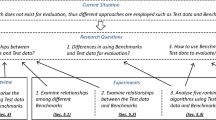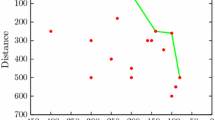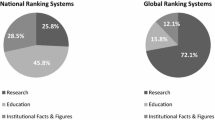Abstract
The application of machine learning algorithms in the construction of ranking models is a relatively new research area which has emerged during the last 10 years within the field of artificial intelligence and information retrieval. This paper presents a bibliometric study of scientific output on learning to rank (L2R) between 2000 and 2013. For this procedure to be successful, every relevant bibliographic L2R record retrieved from the Scopus database was considered. The records were processed according to a series of one-dimensional and multi-dimensional metric indicators which were selected for the study. The results of this research provide the scientific community with reliable, up-to-date information about the state of L2R research and trends, and will enable researchers to develop valuable studies to reinforce research, development and innovation.








Similar content being viewed by others
Notes
Available in http://www.endnote.com/pr-enx4win.asp.
Available from http://www.viscovery.net/somine/.
Available from http://www.arschile.cl/ucinet/.
Available from http://www.analytictech.com/netdraw/netdraw-versions.htm.
Interested readers can consult his comprehensive review of the major approaches to L2R (Liu 2011).
Available from http://research.microsoft.com/en-us/um/beijing/projects/letor/.
References
Bornmann, L., de Moya-Anegón, F., & Leydesdorff, L. (2012). The new excellence indicator in the world report of the SCImago institutions rankings. Journal of Informetrics, 6, 333–335.
Braam, R., & Van-Den-Besselaar, P. (2014). Indicators for the dynamics of research organizations: A biomedical case study. Scientometrics, 99(3), 949–971.
Cañedo, R., Rodríguez, R., & Montejo, M. (2010). Scopus: The largest database of peer-reviewed scientific literature available to underdeveloped countries. ACIMED, 21(3). http://www.acimed.sld.cu/index.php/acimed/article/view/14/45.
Cao, Y., Xu, J., Liu, T.-Y., Li, H., Huang, Y., & Hon, H.-W. (2006). Adapting ranking SVM to document retrieval. In SIGIR 2006: Proceedings of the 29th annual international ACM SIGIR conference on research and development in information retrieval, pp. 186–193.
Dong, Y., Huang, C., & Liu, W. (2014). RankCNN: When learning to rank encounters the pseudo preference feedback. Computer Standards & Interfaces, 36(3), 554–562.
EndNote X4: Getting started guide (2010). Chapter 5 Entering a References. United States, Thomson Reuters.
Joachims, T. (2005). A support vector method for multivariate performance measures. In ICML 2005: Proceedings of the 22nd annual international conference on machine learning, pp. 377–384.
Kohonen, T. (2001). Self-organizing maps (3rd ed.). Berlin: Springer.
Lariviére, V., Sugimoto, C.-R., & Cronin, B. (2012). A bibliometric chronicling of library and information science’s first hundred years. Journal of the American Society for Information Science and Technology, 63(5), 997–1016.
Lin, Y., Lin, H., Xu, K., & Sun, X. (2013). Learning to rank using smoothing methods for language modeling. Journal of the American Society for Information Science and Technology, 64(4), 818–828.
Liu, T.-Y. (2009). Learning to rank for information retrieval. Foundations and Trends in Information Retrieval, 3(3), 225–331.
Liu, T.-Y. (2011). Learning to rank for information retrieval. Berlin, Heidelberg: Springer.
Pritchard, A. (1969). Statistical bibliography or bibliometrics. Journal of Documentation, 25(4), 348–359.
ScienceDirect. What does Scopus cover? \(|\) SciVerse. (Online). http://www.info.sciverse.com/scopus/scopus-in-detail/facts. Accessed: 17-dic-2013.
Tan, J., Fu, H.-Z., & Ho, Y.-S. (2014). A bibliometric analysis of research on proteomics in Science Citation Index Expanded. Scientometrics, 98(2), 1473–1490.
Torres-Salinas, D., & Jiménez-Contreras, E. (2010). Introducción y estudio comparativo de los nuevos indicadores de citación sobre revistas científicas en Journal Citation Reports y Scopus. El Profesional de la Información, 19(2), 201–207.
Valizadegan, H., Jin, R., Zhang, R., & Mao, J. (2009). Learning to rank by optimizing NDCG measure. In NIPS 2009: Proceedings of 23rd annual conference on neural information processing systems, pp. 1883–1891.
Wu, J., Yang, Z., Lin, Y., Lin, H., Ye, Z., & Xu, K. (2011). Learning to rank using query-level regression. In SIGIR 2011: Proceedings of the 34th annual international ACM SIGIR conference on research and development in information retrieval (pp. 1091–1092). ACM Press.
Xu, J., & Li, H. (2007). Adarank: A boosting algorithm for information retrieval. In SIGIR 2007: Proceedings of the 30th annual international ACM SIGIR conference on research and development in information retrieval, pp. 391–398.
Xu, J., Liu, T.-Y., Lu, M., Li, H., & Ma, W.-Y. (2008). Directly optimizing evaluation measures in learning to rank. In SIGIR 2008: Proceedings of the 31st annual international ACM SIGIR conference on research and development in information retrieval, pp. 107–114.
Yan, E., Ding, Y., & Zhu, Q. (2010). Mapping library and information science in China: A coauthorship network. Scientometrics, 83(1), 115–131.
Yeh, J.-Y., Lin, Y.-Y., Ke, H.-R., & Yang, W.-P. (2007). Learning to rank for information retrieval using genetic programming. In SIGIR 2007: Proceedings of SIGIR 2007 workshop on learning to rank for information retrieval.
Acknowledgments
This paper has been supported by the Spanish “Ministerio de Ciencia e Innovación” under projects TIN2011-28538-C02-02 and TIN2013-42741- P.
Author information
Authors and Affiliations
Corresponding author
Rights and permissions
About this article
Cite this article
Alejo-Machado, O.J., Fernández-Luna, J.M. & Huete, J.F. Bibliometric study of the scientific research on “Learning to Rank” between 2000 and 2013. Scientometrics 102, 1669–1686 (2015). https://doi.org/10.1007/s11192-014-1467-4
Received:
Published:
Issue Date:
DOI: https://doi.org/10.1007/s11192-014-1467-4




